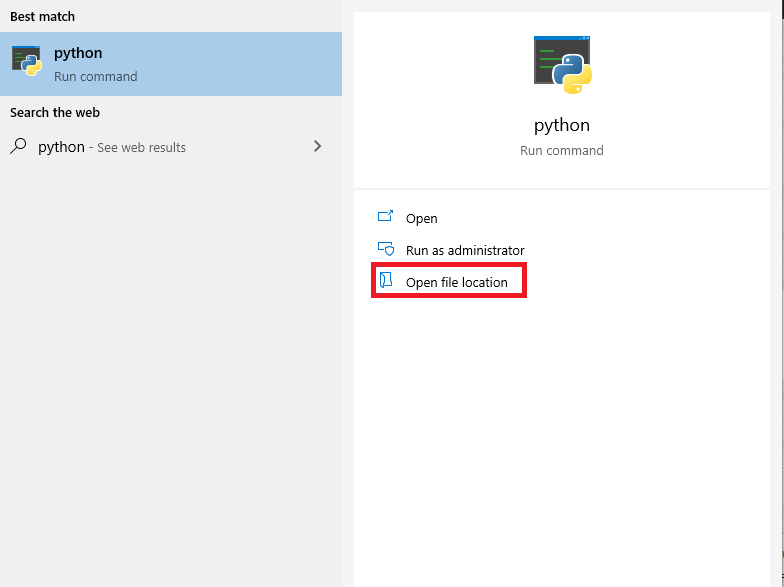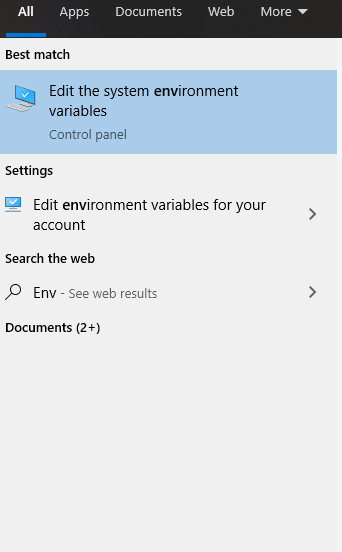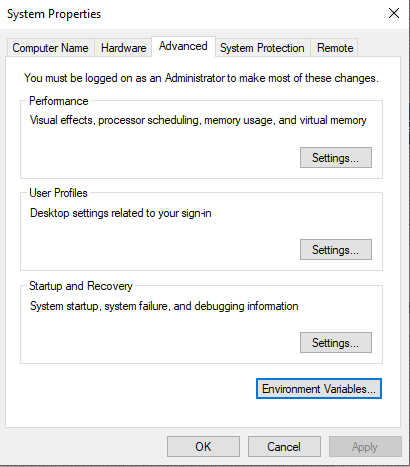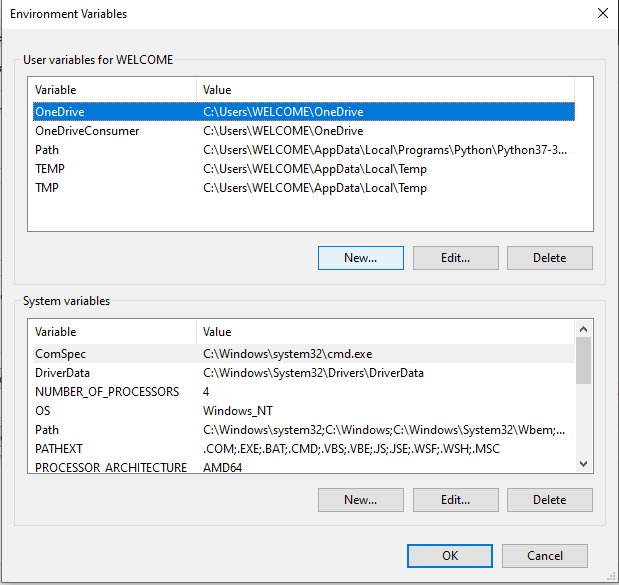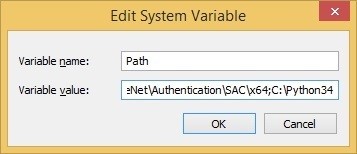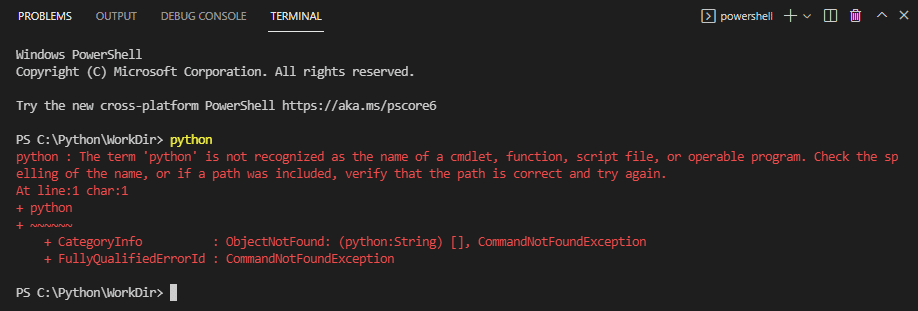The following program will add the python executable path and the subdir Scripts (which is where e.g. pip and easy_install are installed) to your environment. It finds the path to the python executable from the registry key binding the .py extension. It will remove old python paths in your environment. Works with XP (and probably Vista) as well.
It only uses modules that come with the basic windows installer.
# coding: utf-8
import sys
import os
import time
import _winreg
import ctypes
def find_python():
"""
retrieves the commandline for .py extensions from the registry
"""
hKey = _winreg.OpenKey(_winreg.HKEY_CLASSES_ROOT,
r'Python.Fileshellopencommand')
# get the default value
value, typ = _winreg.QueryValueEx (hKey, None)
program = value.split('"')[1]
if not program.lower().endswith(r'python.exe'):
return None
return os.path.dirname(program)
def extend_path(pypath, remove=False, verbose=0, remove_old=True,
script=False):
"""
extend(pypath) adds pypath to the PATH env. variable as defined in the
registry, and then notifies applications (e.g. the desktop) of this change.
!!! Already opened DOS-Command prompts are not updated. !!!
Newly opened prompts will have the new path (inherited from the
updated windows explorer desktop)
options:
remove (default unset), remove from PATH instead of extend PATH
remove_old (default set), removes any (old) python paths first
script (default unset), try to add/remove the Scripts subdirectory
of pypath (pip, easy_install) as well
"""
_sd = 'Scripts' # scripts subdir
hKey = _winreg.OpenKey (_winreg.HKEY_LOCAL_MACHINE,
r'SYSTEMCurrentControlSetControlSession ManagerEnvironment',
0, _winreg.KEY_READ | _winreg.KEY_SET_VALUE)
value, typ = _winreg.QueryValueEx (hKey, "PATH")
vals = value.split(';')
assert isinstance(vals, list)
if not remove and remove_old:
new_vals = []
for v in vals:
pyexe = os.path.join(v, 'python.exe')
if v != pypath and os.path.exists(pyexe):
if verbose > 0:
print 'removing from PATH:', v
continue
if script and v != os.path.join(pypath, _sd) and
os.path.exists(v.replace(_sd, pyexe)):
if verbose > 0:
print 'removing from PATH:', v
continue
new_vals.append(v)
vals = new_vals
if remove:
try:
vals.remove(pypath)
except ValueError:
if verbose > 0:
print 'path element', pypath, 'not found'
return
if script:
try:
vals.remove(os.path.join(pypath, _sd))
except ValueError:
pass
print 'removing from PATH:', pypath
else:
if pypath in vals:
if verbose > 0:
print 'path element', pypath, 'already in PATH'
return
vals.append(pypath)
if verbose > 1:
print 'adding to PATH:', pypath
if script:
if not pypath + '\Scripts' in vals:
vals.append(pypath + '\Scripts')
if verbose > 1:
print 'adding to PATH:', pypath + '\Scripts'
_winreg.SetValueEx(hKey, "PATH", 0, typ, ';'.join(vals) )
_winreg.SetValueEx(hKey, "OLDPATH", 0, typ, value )
_winreg.FlushKey(hKey)
# notify other programs
SendMessage = ctypes.windll.user32.SendMessageW
HWND_BROADCAST = 0xFFFF
WM_SETTINGCHANGE = 0x1A
SendMessage(HWND_BROADCAST, WM_SETTINGCHANGE, 0, u'Environment')
if verbose > 1:
print 'Do not forget to restart any command prompts'
if __name__ == '__main__':
remove = '--remove' in sys.argv
script = '--noscripts' not in sys.argv
extend_path(find_python(), verbose=2, remove=remove, script=script)
You may need to add Python to PATH if you’ve installed Python, but typing python on the command line doesn’t seem to work. You may be getting a message saying that the term python isn’t recognized, or you may end up with the wrong version of Python running.
A common fix for these problems is adding Python to the PATH environment variable. In this tutorial, you’ll learn how to add Python to PATH. You’ll also learn about what PATH is and why PATH is vital for programs like the command line to be able to find your Python installation.
The steps that you’ll need to take to add something to PATH will depend significantly on your operating system (OS), so be sure to skip to the relevant section if you’re only interested in this procedure for one OS.
Note that you can use the following steps to add any program to PATH, not just Python.
How to Add Python to PATH on Windows
The first step is to locate the directory in which your target Python executable lives. The path to the directory is what you’ll be adding to the PATH environment variable.
To find the Python executable, you’ll need to look for a file called python.exe. The Python executable could be in a directory in C:Python or in your AppData folder, for instance. If the executable were in AppData, then the path would typically look something like this:
C:Users<USER>AppDataLocalProgramsPython
In your case, the <USER> part would be replaced by your currently logged-in user name.
Once you’ve found the executable, make sure it works by double-clicking it and verifying that it starts up a Python REPL in a new window.
If you’re struggling to find the right executable, you can use Windows Explorer’s search feature. The issue with the built-in search is that it’s painfully slow. To perform a super-fast full system search for any file, a great alternative is Everything:
Those paths highlighted in yellow, namely those at WindowsApps and Python310, would be ideal candidates to add to PATH because they look like executables at the root level of an installation. Those highlighted in red wouldn’t be suitable because some are part of a virtual environment—you can see venv in the path—and some are shortcuts or internal Windows installations.
You may also encounter Python executables that are installed within the folder for a different program. This is due to the fact that many applications bundle their own version of Python within them. These bundled Python installations would also be unsuitable.
Once you’ve located your Python executable, open the Start menu and search for the Edit the system environment variables entry, which opens up a System Properties window. In the Advanced tab, click on the button Environment Variables. There you’ll see User and System variables, which you’ll be able to edit:
In the section entitled User Variables, double-click on the entry that says Path. Another window will pop up showing a list of paths. Click the New button and paste the path to your Python executable there. Once that’s inserted, select your newly added path and click the Move Up button until it’s at the top.
That’s it! You may need to reboot your computer for the changes to take effect, but you should now be able to call python from the command line.
For setting the PATH environment variable from the command line, check out the section on Configuring Environment Variables in the Windows Python coding setup guide. You can also find instructions in the supplemental materials:
You may also want to set up PATH on your Linux or macOS machine, or perhaps you’re using Windows Subsystem for Linux (WSL). If so, read the next section for the procedure on UNIX-based systems.
How to Add Python to PATH on Linux and macOS
Since Python typically comes pre-installed on UNIX-based systems, the most common problem on Linux and macOS is for the wrong python to run, rather than not finding any python. That said, in this section, you’ll be troubleshooting not being able to run python at all.
The first step is locating your target Python executable. It should be a program that you can run by first navigating to the containing directory and then typing ./python on the command line.
You need to prepend the call to the Python executable with its relative path in the current folder (./) because otherwise you’ll invoke whichever Python is currently recorded on your PATH. As you learned earlier, this might not be the Python interpreter that you want to run.
Often the Python executable can be found in the /bin/ folder. But if Python is already in the /bin/ folder, then it’s most likely already on PATH because /bin/ is automatically added by the system. If this is the case, then you may want to skip to the section on the order of paths within PATH.
Since you’re probably here because you’ve installed Python but it’s still not being found when you type python on the command line, though, you’ll want to search for it in another location.
That said, it might be that /bin/ has been removed from PATH altogether, in which case you might skip forward to the section on mangaging PATH.
Once you’ve located your Python executable and are sure it’s working, take note of the path for later. Now it’s time to start the process of adding it to your PATH environment variable.
First, you’ll want to navigate to your home folder to check out what configuration scripts you have available:
You should see a bunch of configuration files that begin with a period (.). These are colloquially known as dotfiles and are hidden from ls by default.
One or two dotfiles get executed whenever you log in to your system, another one or two run whenever you start a new command-line session, and most others are used by other applications for configuration settings.
You’re looking for the files that run when you start your system or a new command-line session. They’ll probably have names similar to these:
.profile.bash_profile.bash_login.zprofile.zlogin
The keywords to look for are profile and login. You should, in theory, only have one of these, but if you have more than one, you may need to read the comments in them to figure out which ones run on login. For example, .profile file on Ubuntu will typically have the following comment:
# This file is not read by bash(1), if ~/.bash_profile or ~/.bash_login
# exists.
So, if you have .profile but also .bash_profile, then you’ll want to use .bash_profile.
You can also use a .bashrc or .zshrc file, which are scripts that run whenever you start a new command-line session. Run command (rc) files are common places to put PATH configurations.
To add the Python path to the beginning of your PATH environment variable, you’re going to be executing a single command on the command line.
Use the following line, replacing <PATH_TO_PYTHON> with your actual path to the Python executable, and replace .profile with the login script for your system:
$ echo export PATH="<PATH_TO_PYTHON>:$PATH" >> ~/.profile
This command adds export PATH="<PATH_TO_PYTHON>:$PATH" to the end of .profile. The command export PATH="<PATH_TO_PYTHON>:$PATH" prepends <PATH_TO_PYTHON> to the PATH environment variable. It’s similar to the following operation in Python:
>>>
>>> PATH = "/home/realpython/apps:/bin"
>>> PATH = f"/home/realpython/python:{PATH}"
>>> PATH
'/home/realpython/python:/home/realpython/apps:/bin'
Since PATH is just a string separated by colons, prepending a value involves creating a string with the new path, a colon, then the old path. With this string, you set the new value of PATH.
To refresh your current command-line session, you can run the following command, replacing .profile with whichever login script you’ve chosen:
Now, you should be able to call python from the command line directly. The next time you log in, Python should automatically be added to PATH.
If you’re thinking this process seems a bit opaque, you’re not alone! Read on for more of a deep dive into what’s going on.
Understanding What PATH Is
PATH is an environment variable that contains a list of paths to folders. Each path in PATH is separated by a colon or a semicolon—a colon for UNIX-based systems and a semicolon for Windows. It’s like a Python variable with a long string as its value. The difference is that PATH is a variable accessible by almost all programs.
Programs like the command line use the PATH environment variable to find executables. For example, whenever you type the name of a program into the command line, the command line will search various places for the program. One of the places that the command line searches is PATH.
All the paths in PATH need to be directories—they shouldn’t be files or executables directly. Programs that use PATH take each directory in turn and search all the files within it. Subdirectories within directories in PATH don’t get searched, though. So it’s no good just adding your root path to PATH!
It’s also important to note that programs that use PATH typically don’t search for anything except executables. So, you can’t use PATH as a way to define shortcuts to commonly used files.
Understanding the Importance of Order Within PATH
If you type python into the command line, the command line will look in each folder in the PATH environment variable for a python executable. Once it finds one, it’ll stop searching. This is why you prepend the path to your Python executable to PATH. Having the newly added path first ensures that your system will find this Python executable.
A common issue is having a failed Python installation on your PATH. If the corrupted executable is the first one that the command line comes across, then the command line will try and run that and then abort any further searching. The quick fix for this is just adding your new Python directory before the old Python directory, though you’d probably want to clean your system of the bad Python installation too.
Reordering PATH on Windows is relatively straightforward. You open the GUI control panel and adjust the order using the Move Up and Move Down buttons. If you’re on a UNIX-based operating system, however, the process is more involved. Read on to learn more.
Managing Your PATH on UNIX-based Systems
Usually, your first task when managing your PATH is to see what’s in there. To see the value of any environment variable in Linux or macOS, you can use the echo command:
$ echo $PATH
/usr/local/sbin:/usr/local/bin:/usr/sbin:/home/realpython/badpython:/usr/bin:/sbin:/bin:/usr/games:/usr/local/games
Note that the $ symbol is used to tell the command line that the following identifier is a variable. The issue with this command is that it just dumps all the paths on one line, separated by colons. So you might want to take advantage of the tr command to translate colons into newlines:
$ echo $PATH | tr ":" "n"
/usr/local/sbin
/usr/local/bin
/usr/sbin
/home/realpython/badpython
/usr/bin
/sbin
/bin
/usr/games
/usr/local/games
In this example, you can see that badpython is present in PATH. The ideal course of action would be to perform some PATH archaeology and figure out where it gets added to PATH, but for now, you just want to remove it by adding something to your login script .
Since PATH is a shell string, you don’t have access to convenient methods to remove parts of it, like you would if it were a Python list. That said, you can pipe together a few shell commands to achieve something similar:
export PATH=`echo $PATH | tr ":" "n" | grep -v 'badpython' | tr "n" ":"`
This command takes the list from the previous command and feeds it into grep, which, together with the -v switch, will filter out any lines containing the substring badpython. Then you can translate the newlines back to colons, and you have a new and valid PATH string that you use right away to replace your old PATH string.
Though this can be a handy command, the ideal solution would be to figure out where that bad path gets added. You could try looking at other login scripts or examine specific files in /etc/. In Ubuntu, for instance, there’s a file called environment, which typically defines a starting path for the system. In macOS, that might be /etc/paths. There can also be profile files and folders in /etc/ that might contain startup scripts.
The main difference between configurations in /etc/ and in your home folder is that what’s in /etc/ is system-wide, while whatever’s in your home folder will be scoped to your user.
It can often involve a bit of archeology to track down where something gets added to your PATH, though. So, you may want to add a line in your login or rc script that filters out certain entries from PATH as a quick fix.
Conclusion
In this tutorial, you’ve learned how to add Python, or any other program, to your PATH environment variable on Windows, Linux, and macOS. You also learned a bit more about what PATH is and why its internal order is vital to consider. Finally, you also discovered how you might manage your PATH on a UNIX-based system, seeing as it’s more complex than managing your PATH on Windows.
I want to be able to run Python commands from the Windows CMD. However, if I don’t specify Python’s full path for each command, I get an error saying «Python is not recognized as an internal or external command, operable program or batch file.«
How do I add Python to the Windows PATH permanently?
Stevoisiak
13k36 gold badges96 silver badges150 bronze badges
asked May 19, 2010 at 21:54
For Windows 10/8/7:
- Open
System Properties(Right clickComputerin the start menu, or use the keyboard shortcut Win+Pause) - Click
Advanced system settingsin the sidebar. - Click
Environment Variables... - Select
PATHin theSystem variablessection - Click
Edit -
Add Python’s path to the end of the list (the paths are separated by semicolons). For example:
C:Windows;C:WindowsSystem32;C:Python27
For Windows XP:
- Open
System Properties(Type it in the start menu, or use the keyboard shortcut Win+Pause) - Switch to the
Advancedtab - Click
Environment Variables... - Select
PATHin theSystem variablessection - Click
Edit -
Add Python’s path to the end of the list (the paths are separated by semicolons). For example:
C:Windows;C:WindowsSystem32;C:Python27 -
Test on a new terminal window or if using an integrated terminal within a
text editor, close and restart your editor or the changes won’t be applied.
Run5k
15.6k24 gold badges49 silver badges63 bronze badges
answered May 19, 2010 at 21:58
Michael MrozekMichael Mrozek
1,8751 gold badge13 silver badges14 bronze badges
6
For anyone trying to achieve this with Python 3.3+, the Windows installer now includes an option to add python.exe to the system search path. Read more in the docs.
answered Nov 4, 2013 at 9:01
1
- Click on the windows button to start a search
- type in «system env» and click on the «edit system environment variables»
- Now click on the advanced tab on the top
- At the bottom click the button that says «environment variables»
- Now on the «user variables’your user name'» box at the top of the windows click on path then edit
- This should lead to another window where you want to click «new» and type in the commands: «C:Python27» and «C:Python27scripts»
- Python should now work on command prompt
answered Feb 12, 2018 at 20:00
3
As seen in the Python documentation:
Windows has a built-in dialog for
changing environment variables
(following guide applies to XP
classical view): Right-click the icon
for your machine (usually located on
your Desktop and called “My Computer”)
and choose Properties there. Then,
open the Advanced tab and click the
Environment Variables button.In short, your path is:
My Computer ‣ Properties ‣ Advanced ‣
Environment Variables In this dialog,
you can add or modify User and System
variables. To change System variables,
you need non-restricted access to your
machine (i.e. Administrator rights).
Stevoisiak
13k36 gold badges96 silver badges150 bronze badges
answered May 19, 2010 at 21:59
1
Right-click on My Computer, choose Properties. Then find the Environment Variables button (on Win7, it’s under the Advanced tab; I forget where it is on other versions of Windows). Click that, and under System variables, edit the Path one.
answered May 19, 2010 at 21:57
AmberAmber
6015 silver badges4 bronze badges
There are few ways to add Python to Windows PATH. In this guide, you’ll see two methods to add Python to Windows path:
- Via the installation of a recent version of Python
- Manual entry of the paths
Method 1: Install a Recent Version of Python
You can easily add Python to Windows path by downloading a recent version of Python, and then checking the box to Add Python to PATH at the bottom of the setup screen:
Add Python to PATH
Finish the installation, and you should be good to go.
Alternatively, you may manually add the paths into the Environment variables.
Method 2: Manually add Python to Windows Path
If you wish to stick with the previous version of Python, you may apply the steps below to manually add Python to Windows path.
First, navigate to the Windows Environment Variables screen (where you can add/edit your paths):
- Press the Windows Key + R on your keyboard in order to open the Run dialog box
- Type sysdm.cpl to open the System Properties
- Go to the Advanced tab and then click on the ‘Environment Variables…‘
That should take you to the Environment Variables screen, where you can add/edit your paths.
Under the User variables box, click on ‘New…‘ to add the ‘Path’ variable (note that if your ‘Path’ variable already exists, then click on ‘Edit…’ instead):
User variables
OneDrive
TEMP
TMP
New… Edit…
You should then see the New User Variable box, where you may add/edit variables:
Variable name:
Variable value:
Before you type any values, you’ll need to locate the relevant Python paths. The paths that you’ll need to get are:
(1) The Python application path, which is the folder where you originally installed Python. You can find the Python application path by following these steps:
- Type “Python” in the Windows Search Bar
- Right-click on the Python App, and then select “Open file location“
- Right-click again on the Python shortcut, and then select “Open file location“
Here is an example of a Python application path:
C:UsersRonAppDataLocalProgramsPythonPython39
(2) The Python Scripts path. The Scripts folder should be located within the Python application path. Example:
C:UsersRonAppDataLocalProgramsPythonPython39scripts
After you obtained the paths, fill the New User Variable box that you saw earlier:
- For the Variable name, type ‘Path‘
- For the Variable value, copy the full Python application path, then use semicolon (as highlighted in yellow below), and finally copy the Python Scripts path.
For our example:
Variable name: Path
Variable value: C:UsersRonAppDataLocalProgramsPythonPython39;C:UsersRonAppDataLocalProgramsPythonPython39Scripts
Press ‘OK’ and you would then see your new Python Path under the ‘User variables‘ section. Don’t forget to press ‘OK‘ again so that the changes will get implemented.
User variables
OneDrive
Path C:UsersRonAppDataLocalProgramsPythonPython39;C:Users…
TEMP
TMP
New… Edit…
System variables
…
…
…
OK Cancel
You just added Python to the Windows Path.
You should be able to install Python packages easily, by opening the Windows Command Prompt and then typing:
pip install package_name
For example, to install the Pandas package, simply type ‘pip install pandas‘ and then press ENTER:
pip install pandas
Similarly, you may upgrade PIP by typing the following command:
python -m pip install --upgrade pip
Python is a great language! However, it doesn’t come pre-installed with Windows. Hence we download it to interpret the Python code which we write. But wait, windows don’t know where you have installed the Python so when trying to any Python code, you will get an error.
We will be using Windows10 and python3 for this article. (Most of the part is same for any other version of either windows or python)
Add Python to Windows Path
First, we need to locate where the python is being installed after downloading it. Press WINDOWS key and search for “Python”, you will get something like this:
If no results appear then Python is not installed on your machine, download it before proceeding further. Click on open file location and you will be in a location where Python is installed, Copy the location path from the top by clicking over it.
Now, we have to add the above-copied path as a variable so that windows can recognize. Search for “Environmental Variables”, you will see something like this:
Click on that
Now click the “Environmental Variables” button
There will be two categories namely “User” and “System”, we have to add it in Users, click on New button in the User section. Now, add a Variable Name and Path which we copied previously and click OK. That’s it, DONE!
Check if the Environment variable is set or not
Now, after adding the Python to the Environment variable, let’s check if the Python is running anywhere in the windows or not. To do this open CMD and type Python. If the environment variable is set then the Python command will run otherwise not.
Running Python from the terminal is often unavoidable. However, if you just installed Python on Windows 10 for the first time, running it via the Windows Terminal is only possible if it’s added to the Windows PATH environment variable.
It can seem tricky to do, but it’s nothing to fear. To help you overcome the twists involved in adding Python to the Windows PATH after installing it, let’s take a look at the options and the few steps involved.
Why Add Python to Windows PATH?
If you fail to add Python to the PATH on your Windows OS, you can’t run the Python interpreter, start a virtual programming environment, or run commands like pip install from the terminal.
That’s because, when you run any non-default program from the command line, the machine looks for an executable in the current folder, or in the Windows PATH.
If it’s not in the PATH variable, the terminal returns a «command not found» error. Adding to the PATH is powerful, even if you’re executing a command from a created or default batch file, adding its parent execution file to the PATH variable makes it callable from the terminal as well.
How to Manually Add Python to the Windows PATH
First off, if you’ve not installed Python on your machine, go to the python.org website to download and install your preferred version.
Once Python is successfully installed on your PC, check if it’s already added to the Windows PATH. Open up your terminal and type python, then hit the Enter key. The command might return an error that says «‘python’ is not recognized as an internal or external command, operable program or batch file,» indicating that Python isn’t added to your machine’s PATH variable yet.
To execute Python programs from your command line, follow the steps highlighted below.
Find Python’s Installation Path on Your PC
To add Python to your Windows PATH, you need to get its installation path. To do that, open up the Windows search bar and type python.exe (don’t hit the Enter key). Then right-click on Python.exe that pops up in the resulting menu and select the Open file location option.
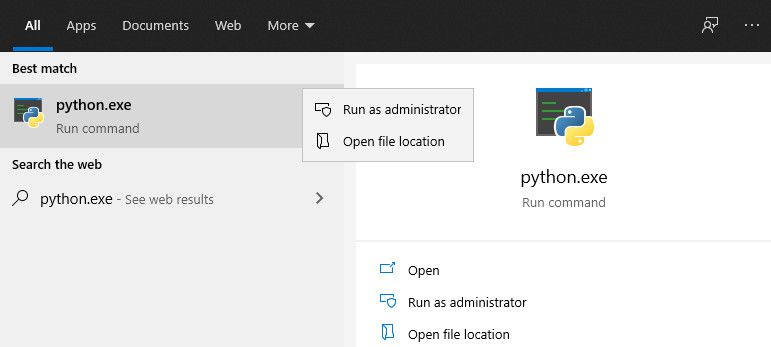
In the Explorer windows that opens, click on the long directory bar to the left of the search bar. Highlight and copy the entire path text to your clipboard with Ctrl + c. Then continue with the next steps below.
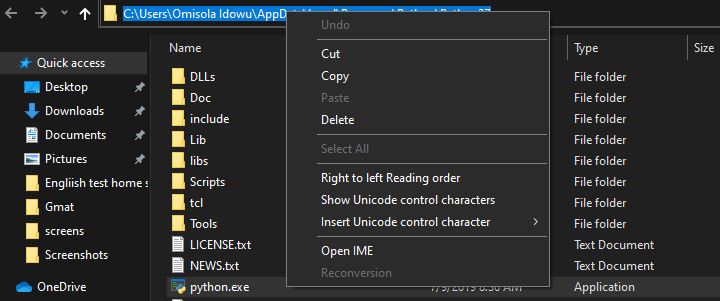
Next: Add Python to PATH in User Variables
To add Python to the PATH in User variables, right-click on This PC, and select Properties. Once in the properties menu, click on the Advanced system settings option. In the next window, select the Advanced tab, and select Environment Variables.
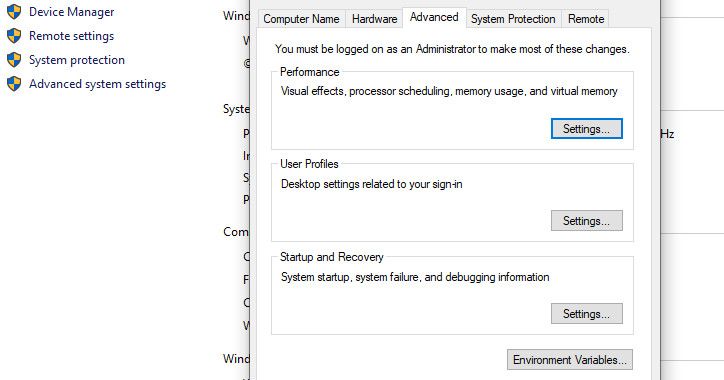
The Environment Variables menu has two distinct parts: an upper part called User variables, and a lower part named System variables. However, our focus is on the User variables in this case.
Within the User variables menu, locate a variable called Path. Then paste the path you copied earlier in the Variable value option using Ctrl + v and click Ok.
However, if you can’t find that variable, you might need to create it. To do that, click on New. Next, in the Variable name form, type Path, and paste your Python path in the Variable value field.
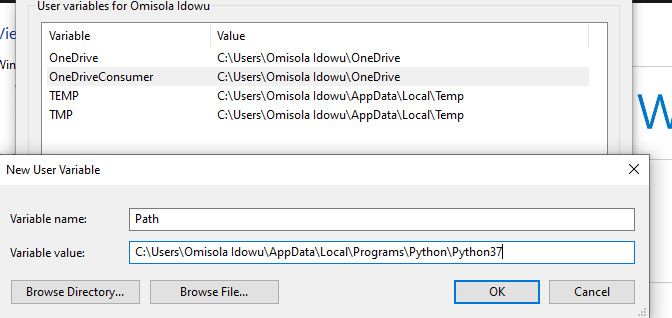
Go back to your Python installation path folder and double-click on Scripts to open that directory. Next, copy its path from the path bar at the upper part of the windows (besides the search bar), just like you did earlier for the Python installation path.
Once you’ve copied the Scripts path, head back to the Environment Variables. Next, select the Path variable and click on Edit. Type a semi-colon after your Python executable path and paste the Scripts path you just copied after it. Then click Ok.
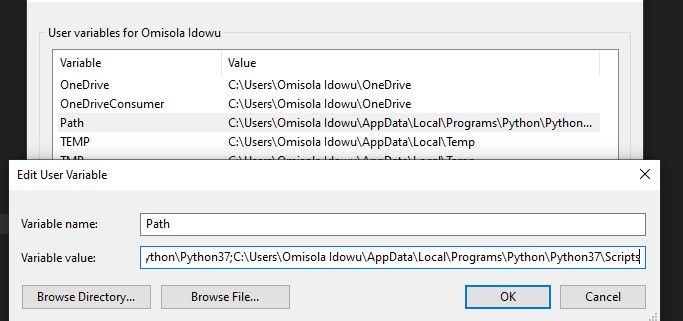
Adding Python to the PATH With the System Variables Option
You can add Python to the System Variables PATH as well. Although this is just an alternative, and it’s not necessary if you’ve added it in the Users variables already.
To use the System Variables option, follow the steps highlighted above for copying the Python path and its Scripts path. Then head back into the Environment Variables. Then, inside the System Variables segment, locate a variable called Path. Click on that variable and click on Edit.
In the next window that comes up, click on New and paste the path you copied earlier in the opened space. Repeat that process for the Scripts path as well. Next, click Ok and close the Environment Variables window.
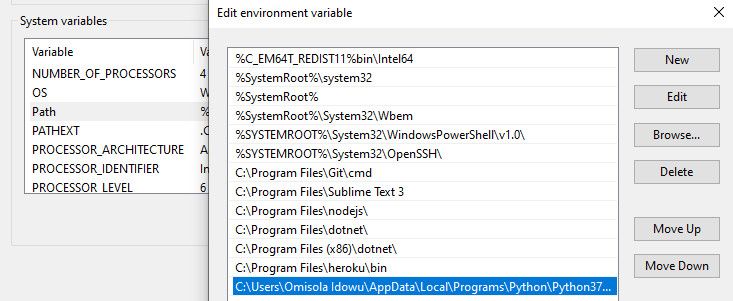
Add Python to Windows PATH Automatically
You can add Python to the Windows PATH automatically during installation as well. Although using this method doesn’t work in all cases, you can still give it a try.
To do that, click on your installation file and check the Add Python 3.7 to PATH box. The version number will change when installing different versions of Python.
Checking that box adds Python to your Windows PATH automatically. That means you can start running Python commands via the command line immediately after installation.
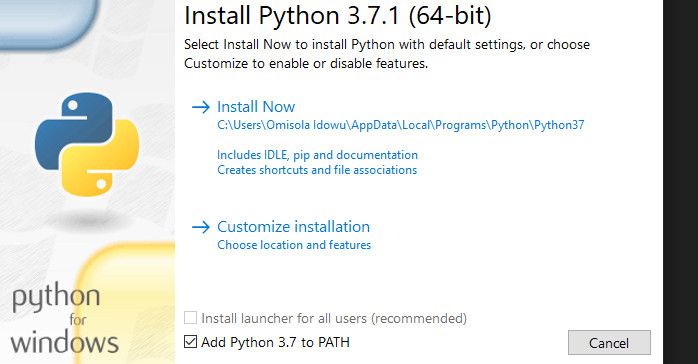
Confirm That Python Is Added to Windows PATH
To see if Python is already added to the Windows PATH, open the terminal and type python —version, then hit the Enter key. If the command returns the currently installed version of Python, it means you’ve successfully added it to the Windows PATH.
However, to check if you’ve added the Scripts directory to the Windows PATH, try to run pip install package on the terminal, replacing «package» with your preferred library. If you’ve installed Python 2.7.9 and above, the command installs the named package, indicating that you’ve successfully added Python’s Scripts to the path as well.

Other Program You Should Consider Adding to the Windows Path
In addition to adding Python to the Windows PATH, you can add text editors, Integrated Development Environments (IDEs), Git, Node, Anaconda, and many other programs.
For instance, managing a project with Sublime Text is easy when you open the terminal to the directory of your project folder and run the subl . command. This opens the editor in your current folder and displays it in the sidebar, another time-saving shortcut for working productively with Sublime Text.
This article will put forth a very simple ye and important concept that is how to add Python to path and follow it up with a detailed practical demonstration. Following pointers will be covered in this article,
- Add Python To Path
- Installing Python
- Setting up Path
- How to add Python Path to Windows?
- Setting Path in Unix or Linux
- Environmental Variables
So let us get started then,
Add Python To Path
Today there is an application for whichever problem you can imagine. Be it in the form of a web application or one that runs on your smartphone, the world of applications is literally an endless pit of opportunities, thus making Python an obvious choice for many developers across the world. The reason for Python being such a popular choice is the plethora of features, the platform comes with.
For developers who are just beginning to learn Python, one might mistakenly install Python in Windows without fulfilling the prerequisites first. One of the most common problems that we hear from developers is how to add path in Python and in this article, we will talk about just that.
But first let’s get the basics out of the way.
Moving on with this article on How To Add Python To Path,
Flavors of Python
Similar to other programming platforms available on the market, Python too is supported by all the operating systems that are currently in existence, most prominently, Linux, Mac OS and Windows.
Installing Python
The most up to date version of Python that is available for download is pretty easy to install. You just need to download the binary code that is applicable for your operating system and install the same. If you find that the binary code is not available for the operating system you are using, you need to make use of a C compiler to compile the source code manually.
One of the most significant advantages of compiling your source code manually is that you will get more flexibility in terms of features that you might need during the installation process.
Moving on with this article on How To Add Python To Path,
Setting up Path
Once you have installed Python on your system, now comes the tricky part of setting path so that you can easily access the python.exe file. Depending on the operating system you are currently using, the process of setting up path varies greatly. Mentioned below are the steps to set up Path for Windows, Mac and Linux simultaneously.
Adding Python Path to Windows
If you have installed Python in Windows like most other developers by just following online tutorials, in most cases there is a chance that the Python executable file wasn’t added to the Windows Path Variable. While this might sound like a small thing at the beginning, when you start using Python full-fledged this will cause a problem. The Python executable file is responsible for listing the directories that will be executed when you type in a command in the command prompt of your Python window. Once you have added the Python executable file in the Windows directory, you will be able to access the python.exe file simply by typing the python keyword. One of the main advantages of adding this feature is that, every time you need to access the python.exe file, you don’t need to specify the full path to the program.
Now let us consider a case, where the Python executable file has not been added to the Windows Path. In such a scenario, when you enter a Python command in the command prompt, you will be greeted by an iteration of the following message.
C:>python
‘python’ is not recognized as an internal or external command,
operable program or batch file.
This message clearly indicates that the python.exe file has not been added to the Windows Path and therefore you won’t be able to access it. In such a scenario, if you want to access the python.exe file you need to specific the full address of the file. It will look something like this,
C:>C:Python34python –version
Python 3.4.3
As you can see from this example, this process is definitely more complicated than what meets the eye and therefore it is always advisable that you add the python executable file to the Windows Path at the very beginning of the installation process.
Moving on with this article on How To Add Python To Path,
How to add Python Path to Windows?
Now that we are aware of the effects of not adding Python Path to Windows, here is a simple method of adding it.
- Start the Run function on your Windows computer, by using the shortcuts ctrl+R.
- Once the Run prompt is up and running, type in sysdm.cpl
- Press Enter and you will be redirected to System Properties. In this section, locate the Advanced Tab and click on the button that reads Environment Variables.
- Under Environment Variables, find System Variables and locate the Path.
- Click on Edit and locate the option which says Variable Value. In this section add the path at the end of the phrase that is already present. One of the most important things to note here is that, before you add the Path you need to include a semicolon (;) so that both can be differentiated easily.
- In our example above, we have added the Path which reads ;C:Python34.
Once this is done, press OK and the path will be added to the specific location. Save all your actions and reboot your system for more effective performance.
Moving on with this article on How To Add Python To Path,
Setting Path in Unix or Linux
The steps for adding Path in Unix or Linux are fairly straight forward, just follow the steps outlined below.
- In the csh shell, type the following sentence: PATH “$PATH:/usr/local/bin/python” and press Enter.
- If you are using the standard flavour of Linux, open up the bash shell and type the following phrase, export PATH=”$PATH:/usr/local/bin/python” and press Enter.
- If you have access to either sh or ksh shell, then open up the terminal and type the following, PATH=”$PATH:/usr/local/bin/python” and press Enter.
One of the most important things to note when you are adding Path to Python in Unix or Linux is that, /usr/local/bin/python is the default path of the Python directory.
Moving on with this article on How To Add Python To Path,
Environmental Variables
Now that you have successfully added Path to Python, here are some of the most significant Environmental Variables that Python recognizes.
-
PYTHONPATH: This is one of the most common Environmental Variables that Python recognizes and it has a role that is similar to the original Path. The use of this variable tells Python where to locate the module files and how to import them into a program. While using this function, be sure to include Python source library directory and also the directories that contain the Python source code. In some instances, PYTHONPATH is already preset in the Python directory.
-
PYTHONSTARTUP: The use of this file contains the path of an initialization file which contains the Python source code. This function is executed every time you start the interpreter in Python. In Unix or Linux, this is named as pythonrc.py and using this command loads the utilities that modify PYTHONPATH.
-
PYTHONCASEOK: This is an Environmental Variable that is specific to Windows. When you use this variable, Python will find the first case insensitive match in an import statement. In order to activate this variable, you can set it to any value of your choice.
-
PYTHONHOME: This is an alternative to module search path that can be used in Python. In most scenarios this is embedded into the PYTHONSTARTUP or PYTHONPATH in order to make switching modules between libraries fairly easy.
This brings us to the end of this article on How To Add Python To Path?
To get in-depth knowledge on Python along with its various applications, you can enroll now for live Python course training with 24/7 support and lifetime access.
Got a question for us? Mention them in the comments section of “Python Tutorial” and we will get back to you.
In today’s tutorial we’ll learn how to to insert Python into the path environment variable on Windows.
What is the Windows Path environment variable?
The path is an environment variable in the Windows operating system that points to certain directories that contain specific executable files that we often use. Directories that we typically find in a Windows path are C:Windows, C:Windowssystem32, %JAVA_HOME%bin etc’.
Why do we want Python in the Path and should we add it?
We want Python to be set as part of the Path so we can refer to the python.exe or to utilities that are part of the Python installation in a relative manner instead of having to write the full absolute path to the executable. In plain words, the meaning of having Python (or any other executable file) in the path, is that in order to invoke Python, we would rather type python than c:Usersdavepython3.10python.exe in our Windows command line.
Python Windows path error messages
We typically encounter error messages when trying to run the Python interpreter from the Windows command line prompt or using the Terminal tab in the popular Python Integrated development environment. Here are a few common errors:
‘python’ is not recognized as an internal or external command, operable program or batch file.
python : The term ‘python’ is not recognized as the name of a cmdlet, function, script file, or operable program.
Error in PyCharm:
‘pip’ is not recognized as an internal or external command, operable program or batch file.
Same error, but this time when invoking pip. Similar error appear when invoking ipython, Mini conda / Anaconda etc’.
Similar Error in Visual Studio Code (VS) Terminal:
Adding Python to the Path automatically
The easiest way to ensure that Python is incorporated into the Path is set that accordingly when installing Python on your Windows computer. That said, even after you have already installed Python you can still use the Python installer to fix the path topic in two ways.
- First off, close any open Python files or the command prompt terminal windows.
- Then run the Python application setup executable file that matches the one installed in your computer.
- You’ll see the following dialog:
- Then select Modify, then hit Next.
- In the Advanced Options dialog mark the add Python to ENVIRONMENT variables checkbox as shown below. Then hit Install and and once done close the Setup dialog.
- Alternatively, run the Python executable file that matches the one installed in your computer.
- From the Modify Setup dialog, select Repair.
- If prompted by User Account Control hit Yes.
- The Repair Progress dialog will show the Python installation repair.
- Once done, hit Close.
The Python application and scripts folder were added to the Path.
Add Python to Path – manually
You can obviously edit your PATH environment manually .Kindly proceed as following to insert the Python directories to the path:
- On your Windows taskbar hit the magnifying glass button (search).
- In the Type here to search box, type Environment variables and hit Enter.
- The System Properties dialog will open up.
- In the bottom hit the Environment Variables button.
- In the System Variables section, highlight the Path entry.
- Hit Edit.
- Now, hit New.
- Add the absolute path to your Python.exe file. For example: C:PythonPython3.10
- Now hit New again.
- Add the absolute path to your Python Scripts library.For example: C:PythonPython3.10Scripts
- Your dialog should look as following:
- Hit OK.
- Close the Environment Variables and System Properties dialogs.
- Restart your Python IDE or Command Prompt and invoke your Python application using the relative path as shown below:
- You are all set!
Adding PIP to the Path
The Python Package Manager utility PIP is accessible as an executable (exe) file right in your Python Scripts folder typically at <python_installation_directory>Scripts.
If you path is not set correctly you will get the following error when trying to install a package or to update PIP:
You can easily solve the error by manually setting the Windows path or re-installing Python as shown in the sections above.
Enjoy 🙂


